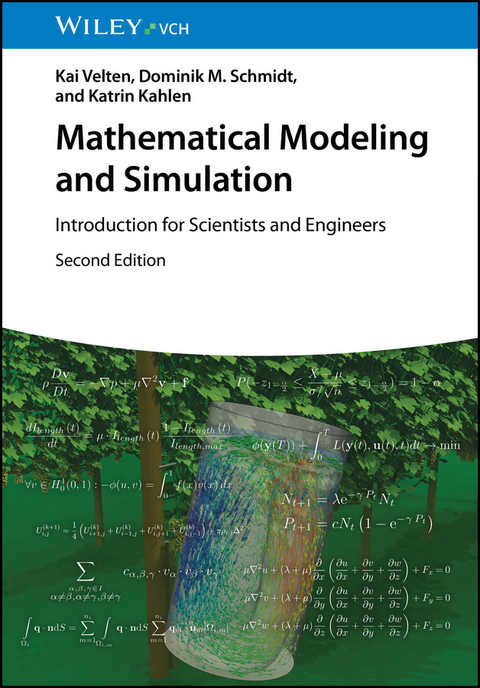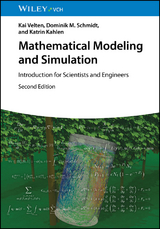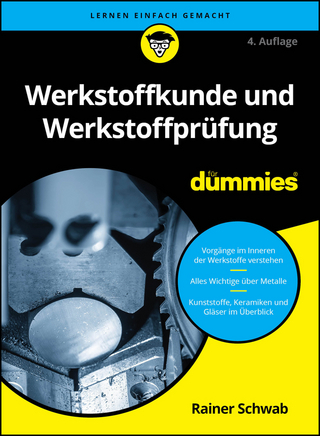Mathematical Modeling and Simulation
Wiley-VCH (Verlag)
978-3-527-41414-7 (ISBN)
This completely revised and substantially extended second edition answers the most important questions in the field of modeling: What is a mathematical model? What types of models do exist? Which model is appropriate for a particular problem? What are simulation, parameter estimation, and validation? What kind of mathematical problems appear and how can these be efficiently solved using professional free of charge open source software?
The book addresses undergraduates and practitioners alike. Although only basic knowledge of calculus and linear algebra is required, the most important mathematical structures are discussed in sufficient detail, ranging from statistical models to partial differential equations and accompanied by examples from biology, ecology, economics, medicine, agricultural, chemical, electrical, mechanical, and process engineering.
About 200 pages of additional material include a unique chapter on virtualization, Crash Courses on the data analysis and programming languages R and Python and on the computer algebra language Maxima, many new methods and examples scattered throughout the book and an update of all software-related procedures and a comprehensive book software providing templates for typical modeling tasks in thousands of code lines.
The book software includes GmLinux, an operating system specifically designed for this book providing preconfigured and ready-to-use installations of OpenFOAM, Salome, FreeCAD/CfdOF workbench, ParaView, R, Maxima/wxMaxima, Python, Rstudio, Quarto/Markdown and other free of charge open source software used in the book.
Kai Velten is Professor of Mathematics, Statistics, Mathematical Modeling and Simulation at the Hochschule Geisenheim University, Germany, and a modeling and simulation consultant. Having studied mathematics, physics and economics at the Universities of Göttingen and Bonn, he worked at Braunschweig Technical University and at Erlangen University (Institute of Applied Mathematics). From 1996-2000, he held a post as project manager and group leader at the Fraunhofer-ITWM in Kaiserslautern (consultant projects for the industry). His research emphasizes differential equation models and is documented in approx. 40 scientific publications and one patent.
Katrin Kahlen is Professor in the Department of Modeling & Systems Analysis at the Hochschule Geisenheim University, Germany. She obtained a PhD from the University of Hannover in 2000, followed by postdoctoral work in a Collaborative Research Centre (SFB 326). After that, she worked at the Institute of Vegetable Crops and Systems' Modelling at the University of Hannover where she did her habilitation in 2011 in the field of agronomy.
Dominik Maria Schmidt is Senior Researcher in the Department of Modeling & Systems Analysis at the Hochschule Geisenheim University, Germany. He is currently involved in DFG-funded research project on modelling virtual Riesling canopies for reducing sunburn risks in grapevine berries.
Preface
1 PRINCIPLES OF MATHEMATICAL MODELING
1.1 A Complex World Needs Models
1.2 Systems, Models, Simulations
1.3 Mathematics as a Natural Modeling Language
1.4 Definition of Mathematical Models
1.5 Examples and Some More Definitions
1.6 Even More Definitions
1.7 Classification of Mathematical Models
1.8 Everything Looks Like a Nail?
2 PHENOMENOLOGICAL MODELS
2.1 Elementary Statistics
2.2 Linear Regression
2.3 Multiple Linear Regression
2.4 Nonlinear Regression
2.5 Smoothing Splines
2.6 Neural Networks
2.7 Big Data Analysis
2.8 Signal Processing
2.9 Design of Experiments
2.10 Other Phenomenological Modeling Approaches
3 MECHANISTIC MODELS I: ODES
3.1 Distinguished Role of Differential Equations
3.2 Introductory Examples
3.3 General Idea of ODE?s
3.4 Setting Up ODE Models
3.5 Some Theory You Should Know
3.6 Solution of ODE?s: Overview
3.7 Closed Form Solutions
3.8 Numerical Solutions
3.9 Fitting ODE?s to Data
3.10 More Examples
4 MECHANISTIC MODELS II: PDES
4.1 Introduction
4.2 The Heat Equation
4.3 Some Theory You Should Know
4.4 Closed Form Solutions
4.5 Numerical Solution of PDE?s
4.6 The Finite Difference Method
4.7 The Finite Element Method
4.8 The Finite Volume Method
4.9 Software packages to solve PDEs
4.10 A Sample Session on the Numerical Solution of Thermal Conduction
4.11 A Look Beyond the Heat Equation
4.12 Computational Fluid Dynamics (CFD)
4.13 Numerical solutions of exaple flow problems
5 VIRTUALIZATION
5.1 Introduction
5.2 Virtual Plants
5.3 Examples of Advanced Applications
6 CRASH COURSES AND BOOK SOFTWARE
6.1 Crashcourse R
6.2 Crashcourse Maxima
6.3 CrashCrashcourse Python (and all the rest)
6.4 Book software and GmLinux
References
Index
Reviews of the first edition (2009):
»Perfectly fits introductory modeling courses [...] and is an enjoyable reading in the first place. Highly recommended [...]«
Zentralblatt MATH, European Mathematical Society, 2009
»This book differs from almost all other available modeling books in that [the authors address] both mechanistic and statistical models as well as 'hybrid' models. [...] The modeling range is enormous.«
SIAM Society of Industrial and Applied Mathematics, USA, 2011
| Erscheinungsdatum | 07.08.2024 |
|---|---|
| Verlagsort | Berlin |
| Sprache | englisch |
| Maße | 170 x 244 mm |
| Gewicht | 666 g |
| Themenwelt | Naturwissenschaften ► Chemie |
| Naturwissenschaften ► Physik / Astronomie | |
| Technik ► Maschinenbau | |
| Schlagworte | Chemie • Chemistry • Computational Chemistry & Molecular Modeling • Computational Chemistry u. Molecular Modeling • Materials Science • Materialwissenschaften • Materialwissenschaften / Theorie, Modellierung u. Simulation • Mathematical & Computational Physics • Mathematical Modeling • Mathematics • Mathematik • Mathematische Modellierung • Mathematische Physik • Modell (Math.) • Physics • Physik • Simulation • Theory, Modeling & Simulation |
| ISBN-10 | 3-527-41414-2 / 3527414142 |
| ISBN-13 | 978-3-527-41414-7 / 9783527414147 |
| Zustand | Neuware |
| Informationen gemäß Produktsicherheitsverordnung (GPSR) | |
| Haben Sie eine Frage zum Produkt? |
aus dem Bereich




